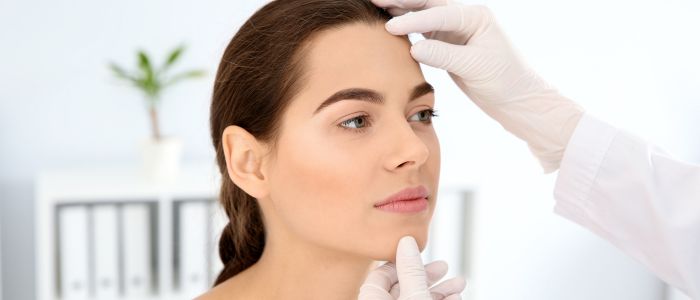
Table of Contents
- Identifying the Warning Signs and Types of Skin Cancer
- Types of Skin Cancer
- Basal Cell Carcinoma (BCC)
- Squamous Cell Carcinoma (SCC)
- Melanoma
- ABCDE System for Self-assessment
- Are there any additional factors or warning signs beyond the ABCDE system that individuals should be aware of when checking their skin?
- Sun Exposure and Risk of Skin Cancer
- When to Seek Medical Advice
- FAQs about What Does Skin Cancer Look Like
- Further Reading about Skin Cancer Procedures at Cheshire Cosmetic Surgery
Identifying the Warning Signs and Types of Skin Cancer
Skin cancer continues to rise in the UK and globally, the overall statistics being a cause for great concern. Research has shown that of people aged 55 or over, some 70% will develop skin cancer. It is, sadly, a problem that will come to many of us.
For most, though, there is uncertainty as to what skin cancer actually looks like. Which blemish is of no concern, which one might signify cancer and then which type of skin cancer might it be?
If the surface of the skin has changed, is that cause for concern, which parts of the body should someone particularly focus on if looking for any evidence of problems?
In this post, Anca Breahna, a plastic and cosmetic surgeon with specialist knowledge in the field of skin cancer and its treatment, will provide some key information.
Types of Skin Cancer
Basal Cell Carcinoma (BCC)
Basal Cell Carcinoma, also known as Rodent Ulcer, is the most common type of skin cancer, accounting for around 80% of cases. Basal Cell Carcinoma develops in the basal cells, which are responsible for producing new skin cells as old ones die off. Although it is the least aggressive of the three main types of skin cancer, it still requires medical attention and may necessitate surgery. Basal Cell Carcinoma rarely spreads to other parts of the body (metastasizes) but can cause significant damage to cells near the cancer site, leading to disfigurement if left untreated.
What to Look for:
- New small, pearly, or waxy bumps, usually on sun-exposed areas such as the face, ears, and neck
- Flat, flesh-coloured, or brown scar-like lesions
- Bleeding or scabbing sores that heal and then return
- More common in people with fair skin, but can occur in all skin types
- Risk factors for this carcinoma include excessive sun exposure, tanning bed use, and a
history of sunburns
Squamous Cell Carcinoma (SCC)
Squamous Cell skin cancer is the second most common form of skin cancer, accounting for about 20% of cases. Squamous Cell Carcinoma develops in the squamous cells, which make up the middle and outer layers of the skin. Squamous Cell Carcinoma poses a greater risk to health than Basal Cell Carcinoma because it can grow larger and spread to other parts of the body if left untreated. However, this type of carcinoma can be effectively treated, especially if detected early.
What to Look for:
- Scaly red patches, open sores, or elevated growths with a central depression, often on sun-exposed areas like the face, ears, neck, lips, and hands (areas not covered with clothing)
- Wart-like growths that may crust or bleed
- Persistent, non-healing sores or ulcers
- This non-melanoma skin cancer can spread to other parts of the body (metastasize), requiring prompt treatment
- Risk factors for this carcinoma include excessive sun exposure, tanning bed use, a
history of sunburns, and a weakened immune system
Melanoma
Melanoma is the most serious and aggressive type of cancer affecting the skin, accounting for about 1% of all skin cancer cases. However, it is responsible for the majority of skin cancer deaths. Melanoma develops in the melanocytes, the cells that produce the pigment that gives skin its colour. Melanoma can spread to other parts of the body quickly, making early detection and appropriate treatment crucial for effective management.
What to Look for:
- New mole or changes to an existing mole, such as size, shape, or colour
- Asymmetrical moles with irregular borders and multiple colours (shades of brown, black, tan, red, white, or blue)
- Moles larger than 6mm in diameter (about the size of a pencil eraser)
- Itching, bleeding, or crusting moles
- Dark lesions on the palms, soles, fingertips, toes, or mucous membranes (mouth, nose, or genitals)
- Risk factors include excessive sun exposure, tanning bed use, a history of sunburns, a large number of moles, and a family history of melanoma
ABCDE System for Self-assessment
The ABCDE system is a simple and effective method for self-assessment of moles and other skin lesions to help identify potential signs of melanoma, the most serious form of skin cancer. This system focuses on five key characteristics: Asymmetry, Border, Colour, Diameter, and Evolution.
-
- Asymmetry – uneven halves
-
- Border – irregular, crusted, or notched
-
- Colour – changes or variations in colour
-
- Diameter – typically 6mm or more, but can be smaller
-
- Evolving – mole changing over time
Asymmetry refers to the shape of the mole. If you were to draw an imaginary line through the centre of the mole, the two halves should match. If they don’t, this asymmetry could be a warning sign of melanoma.
Border irregularity is another important factor. Benign moles typically have smooth, even borders, while melanomas often have ragged, notched, or blurred edges.
Colour variations within a mole can also be a cause for concern. Benign moles usually have a single, uniform colour. Melanomas, on the other hand, may display a range of colours, including shades of black, brown, tan, red, white, or blue.
Diameter is the fourth characteristic to consider. Moles larger than 6mm in diameter (about the size of a pencil eraser) are more likely to be melanomas. However, it’s important to note that melanomas can be smaller than this, so don’t ignore a mole just because it’s small.
Finally, Evolution refers to changes in a mole over time. Benign moles typically remain stable, while melanomas may change in size, shape, colour, or texture. They may also begin to itch, bleed, or crust over.
By using the ABCDE system regularly to monitor your moles and skin lesions, you can detect potential signs of melanoma early, when it is most treatable. If you notice any concerning changes, it’s crucial to consult a doctor promptly for a thorough evaluation and appropriate treatment if necessary. Remember, early detection is key to successfully managing melanoma and other types of skin cancer.
Are there any additional factors or warning signs beyond the ABCDE system that individuals should be aware of when checking their skin?
Yes, there are several additional factors and warning signs beyond the ABCDE system that individuals should be aware of when checking their skin:
- The “Ugly Duckling” Sign: This refers to a mole that looks significantly different from the
surrounding moles. It may be larger, smaller, darker, lighter, or have a different shape or texture. This could be a warning sign of melanoma. - Skin sores or skin spots that don’t heal: If you have a sore, cut, or bruise that does not heal within a few weeks, it could be a sign of skin cancer, particularly squamous cell carcinoma or basal cell carcinoma.
- Persistent redness or irritation: If you have a patch of skin that is consistently red, itchy, or irritated, and does not improve with moisturisers or over-the-counter treatments, it could be a sign of early skin cancer.
- Tender or painful lesions: While skin cancers are often painless, in some cases, they may be tender or painful to the touch. This can be a sign of a more advanced skin cancer.
- Scaly or crusted patches: Rough, scaly, or crusted patches on the skin that do not improve with moisturising could be a sign of actinic keratosis, a precancerous condition that can develop into squamous cell carcinoma if left untreated.
- Pimple-like growths: Basal cell carcinomas can sometimes resemble pimples that don’t go away or heal. They may be pearly, translucent, or have visible blood vessels.
- Nail changes: Melanomas can also develop under the fingernails or toenails. Warning signs include dark streaks or spots under the nail, nail lifting or separating from the nail
bed, and nail cracking or breaking.
If you notice any concerning changes in your skin, it’s essential to consult a specialist for a thorough evaluation. Anca can determine whether a biopsy or further treatment is necessary.
Sun Exposure and Risk of Skin Cancer
Sun exposure or exposure to UV light is a significant risk factor for all skin cancer types for darker skin tones and light skin. Priority should be given to checking areas that receive the most sun exposure, such as the face, arms, legs, and the backs of hands where cancer cells can occur.
When to Seek Medical Advice
If you notice any changes to your normal skin, such as abnormal moles with jagged borders, nodules, ulcers, alterations to existing moles, skin growths, or a shiny bump it is essential to seek medical advice as they could be symptoms of skin cancer. While it may be difficult to self-diagnose, regular self-checks can help you identify changes that require attention, even if they occur at the deeper layers of the epidermis. Consult your GP or a cosmetic surgeon with relevant experience, like Anca Breahna, for a professional assessment and potential treatment options.
If you would like further information or to discuss your options for consultation please contact Miss Breahna by calling us at 07538 012918 or email at contact@ancabreahna.com.
FAQs about What Does Skin Cancer Look Like

What is actinic keratosis, and how is it related to skin cancer?
Actinic keratosis is a precancerous skin condition characterised by rough, scaly patches on sun-exposed areas of the skin. This scaly skin patch is caused by long-term exposure to ultraviolet (UV) radiation and can develop into squamous cell carcinoma if left untreated. Actinic keratosis is an early warning sign of potential skin cancer, and individuals with this condition should be monitored closely by a doctor.
Are people with a history of skin cancer more likely to develop new skin cancers?
Yes, individuals with a history of carcinoma have a higher risk of skin cancer development in the future. This is because their skin has already shown a susceptibility to the damaging effects of UV radiation, and they may have underlying genetic or environmental risk factors. If you have a history of skin cancer, it’s essential to be vigilant about sun protection, perform regular self-exams, and schedule frequent skin checks with a specialist.
Can skin cancer develop in any layers of skin?
Yes, different types of skin cancer can originate in different layers of the skin. Basal cell carcinoma develops in the basal cell layer of the epidermis (the outermost layer of skin), while squamous cell skin cancer arises from the squamous cells in the upper layers of the epidermis. Melanoma, the most serious type of skin cancer, develops in the melanocytes, which are found in the lower part of the epidermis.
How can I distinguish between normal moles and potentially cancerous ones?
Normal moles are typically symmetrical, with smooth borders and a uniform colour. They are usually smaller than 6mm in diameter and do not change over time. Moles that are asymmetrical, have irregular borders, display multiple colours, are larger than 6mm, have an abnormal growth or change in size, shape, or colour over time may be indicative of melanoma. If you notice any atypical moles that deviate from the appearance of your normal moles, consult a specialist for a professional assessment as they could be signs of skin cancer.
What causes abnormal cells to develop into skin cancer?
Abnormal cells that lead to skin cancer are primarily caused by damage to the DNA in skin cells due to exposure to UV radiation from the sun or tanning beds. Other factors that can contribute to the development of abnormal cells include genetic predisposition, a weakened immune system, exposure to certain chemicals or toxins, and chronic inflammation or irritation of the skin. When these abnormal cells grow and divide uncontrollably, they can form a cancerous tumour in the affected layer of the skin.
Medical References about What Does Skin Cancer Look Like
Further Reading about Skin Cancer Procedures at Cheshire Cosmetic Surgery
- Read more about Excision Biopsy
- Read more about Skin Graft Surgery
- Read more about What to Expect During and After an Excision Biopsy for Suspected Skin Cancer
- Read more about Treatments and Solutions for Skin Cancer
- Read more about Treatment and Solutions for Skin Moles








